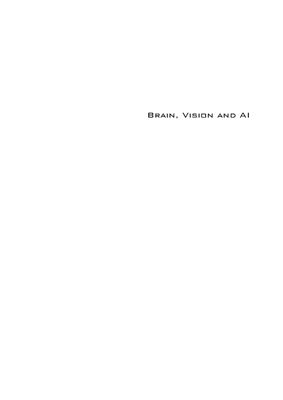Издательство InTech, 2008, -292 pp.
There is no doubt that Brain, Vision and Artificial Intelligence are among the new frontiers of science and research; in addition these topics are particularly interesting both for the young scientists and for the less young ones. Moreover, this field of research is very multidisciplinary: the scientists that carry on researches on these topics belong to wide number of different academic education since different aspects of physics, engineering and also medicine are involved. It is really exciting to meet, at the conferences on this topic, such a number of different knowledge all together.
It is possible to affirm that the results of the researches on Vision and AI will lead up to considerable changes in many fields: researches on AI will improve, for instance, the interaction between man and computer; Vision involves the robotic vision and automation, the analysis of motion, the diagnostics, the cultural heritages conservation, security and surveillance. Recent applications already permit to machines and other devices to interact with man and with the environment; this had never happened in the history of man and, until few decades ago, it seemed just science fiction.
The scientists that have contributed to this book have studied different aspects of these disciplines, therefore it is also impossible to summarize the results of their researches. Briefly, the main field of research conceed vision models, visual perception of motion, neuron models, detection and restoration, models of cellular development, multiple image detection and processing, 3D vision, human movement analysis, artificial vision applications to robotics, AI application to prediction of trip generation and distribution, applications to the replication process of the CBSRSAS systems, MOPT, ranking and extraction of single words in a text.
The Authors that have contributed to this book work at Universities and Research Institutes, practically, all over the world and the results of their researches have been published on inteational jouals and appreciated in many inteational conferences.
Visual Perception of Semi-transparent Blotches: Detection and Restoration
2. Computing the Vulnerable Phase in a 2D Discrete Model of the Hodgkin-Huxley Neuron
Bio-inspired Connectionist Modelling: An Application to Visual Perception of Motion
Cell Patte Generation in Artificial Development
I’m Sorry to Say, But Your Understanding of Image Processing Fundamentals Is Absolutely Wrong
Multiple Image Objects Detection, Tracking, and Classification using Human Articulated Visual Perception Capability
Consideration of various Noise Types and Illumination Effects for 3D shape recovery
Cooperative intelligent agents for speeding up the Replication of Complement-Based Self-Replicated, Self-Assembled Systems (CBSRSAS)
Investigating the Performance of Rule-based Models with Increasing Complexity on the Prediction of Trip Generation and Distribution
Laban Movement Analysis using a Bayesian model and perspective projections
Video System in Robotic Applications
Multiple Object Permanence Tracking: Maintenance, Retrieval and Transformation of Dynamic Object Representations
Ranking and Extraction of Relevant Single Words in Text
There is no doubt that Brain, Vision and Artificial Intelligence are among the new frontiers of science and research; in addition these topics are particularly interesting both for the young scientists and for the less young ones. Moreover, this field of research is very multidisciplinary: the scientists that carry on researches on these topics belong to wide number of different academic education since different aspects of physics, engineering and also medicine are involved. It is really exciting to meet, at the conferences on this topic, such a number of different knowledge all together.
It is possible to affirm that the results of the researches on Vision and AI will lead up to considerable changes in many fields: researches on AI will improve, for instance, the interaction between man and computer; Vision involves the robotic vision and automation, the analysis of motion, the diagnostics, the cultural heritages conservation, security and surveillance. Recent applications already permit to machines and other devices to interact with man and with the environment; this had never happened in the history of man and, until few decades ago, it seemed just science fiction.
The scientists that have contributed to this book have studied different aspects of these disciplines, therefore it is also impossible to summarize the results of their researches. Briefly, the main field of research conceed vision models, visual perception of motion, neuron models, detection and restoration, models of cellular development, multiple image detection and processing, 3D vision, human movement analysis, artificial vision applications to robotics, AI application to prediction of trip generation and distribution, applications to the replication process of the CBSRSAS systems, MOPT, ranking and extraction of single words in a text.
The Authors that have contributed to this book work at Universities and Research Institutes, practically, all over the world and the results of their researches have been published on inteational jouals and appreciated in many inteational conferences.
Visual Perception of Semi-transparent Blotches: Detection and Restoration
2. Computing the Vulnerable Phase in a 2D Discrete Model of the Hodgkin-Huxley Neuron
Bio-inspired Connectionist Modelling: An Application to Visual Perception of Motion
Cell Patte Generation in Artificial Development
I’m Sorry to Say, But Your Understanding of Image Processing Fundamentals Is Absolutely Wrong
Multiple Image Objects Detection, Tracking, and Classification using Human Articulated Visual Perception Capability
Consideration of various Noise Types and Illumination Effects for 3D shape recovery
Cooperative intelligent agents for speeding up the Replication of Complement-Based Self-Replicated, Self-Assembled Systems (CBSRSAS)
Investigating the Performance of Rule-based Models with Increasing Complexity on the Prediction of Trip Generation and Distribution
Laban Movement Analysis using a Bayesian model and perspective projections
Video System in Robotic Applications
Multiple Object Permanence Tracking: Maintenance, Retrieval and Transformation of Dynamic Object Representations
Ranking and Extraction of Relevant Single Words in Text

